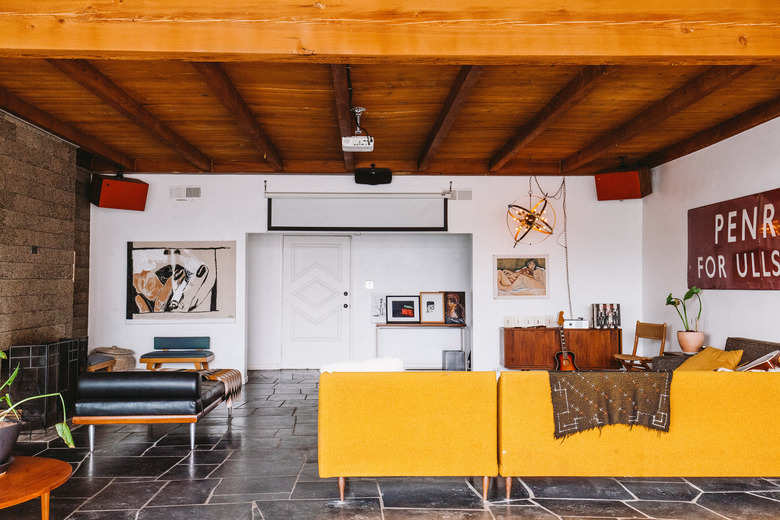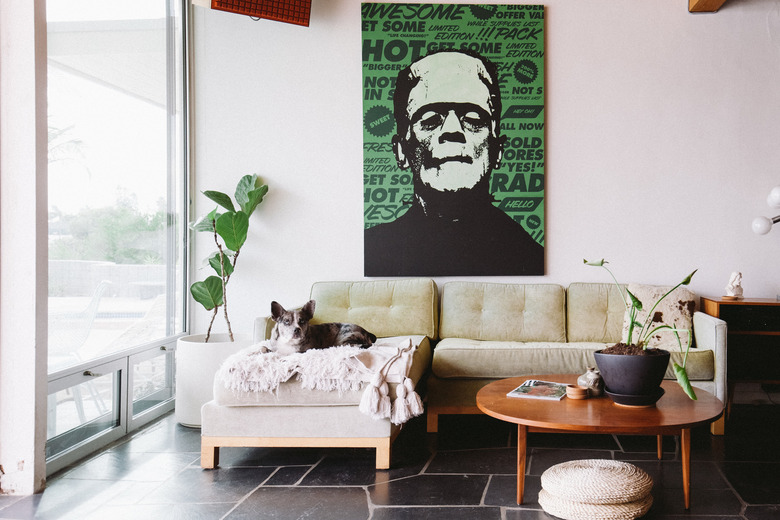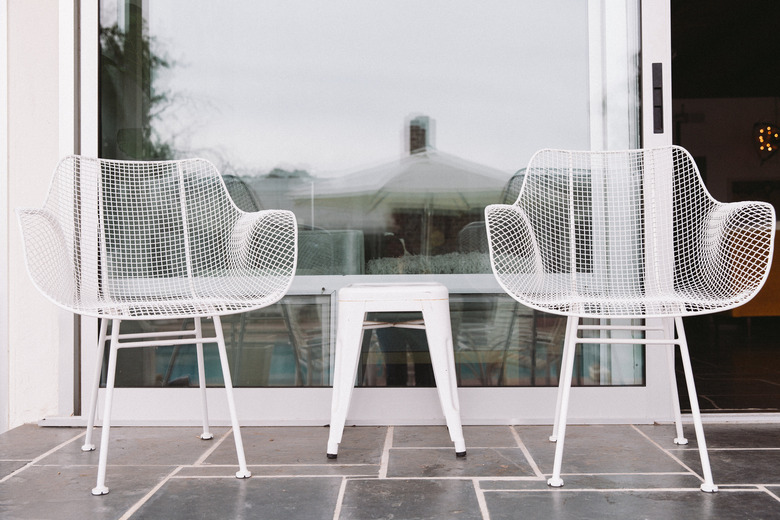Slate Tile: A Homeowner's Tile Flooring Guide
Known for its beauty and super strength, slate tile is a natural stone option that creates gorgeous floors that are able to handle quite a bit of wear and tear. Though not typically the most affordable flooring option, its beauty, resilience and low-maintenance requirements still make it worth the splurge for many homeowners. If you're considering it as an option for your own floors, learning more about it can help guide you in your decision.
Advantages of Slate Tile
Advantages of Slate Tile
Slate has all kinds of pros worth factoring into your flooring decision:
- Durability: Slate is one of the toughest natural stones you can buy as a flooring option. Since it has put up with centuries of extreme temperatures and pressures during its formation on Earth, it can usually handle anything your home throws at it. Slate floor is incredibly resistant to dents, scuffs and scratches. Additionally, even if it does get a small scratch o r scuff, the natural grooves and ridges of slate often do a good job of hiding it, unlike softer or sleeker natural flooring options such as hardwood or marble.
- Water resistance: The same history that's made slate nearly impervious to scratches also makes it highly water resistant. This makes it a great option for places like bathrooms and kitchens as well as for outdoor spaces like garden paths and patios since it can hold up against shower steam, spills, sprinklers and rain.
- All natural: We now know that options like some types of carpeting, vinyl flooring and laminate can carry toxins — or what the Environmental Protection Agency calls volatile organic compounds, or VOCs — including formaldehyde, lead, phthalates and flame retardants. Slate has none of these.
- Eco-friendly: Since slate is all natural, it's a more environmentally conscious option, especially when it's locally sourced and when you choose a VOC-free sealant. In the same vein, natural slate (and other natural stones) can be an energy-efficient option if you have radiant heating since it does a great job transmitting heat into the room.
Disadvantages of Slate Tile
Disadvantages of Slate Tile
Though full of many flooring advantages, it's worth considering the ways that slate might not be right for your home:
- Cost: High price points are one of the biggest reasons people say no to slate floor tiles. Usually in the $4 to $11 range per square foot but also found as high as $15 to $25, it's an expensive option even for a natural stone and potentially not possible depending on your budget. However, its high price point isn't completely without merit. Its durability means it can last for decades, and natural stones are also usually a great way to entice buyers for future home sales.
- Comfort: Slate's hardness makes it resilient, but it can also lead to it being cold and uncomfortable to walk on barefoot. If you're trying to find flooring for a homey, cozy room or you live in a chilly climate, you might be thinking about a softer and warmer option to walk on, such as carpeting, vinyl or cork.
Design Opportunities With Slate
Design Opportunities With Slate
In addition to its practical advantages as a flooring option, one of the most appealing things about slate is its appearance. Grand and mysterious without being too dark or foreboding, it is one of the first things that people love about slate flooring.
According to the Encyclopaedia Britannica, slate is a metamorphic rock made up of materials including clay minerals, micas and quartz. Another metamorphic rock is quartzite. Slate is often richly textured and the shade of charcoal but is also available in color variations including olive greens, sandy or golden tans, ocean blues and burnt reds, and it can even have flecks of deep sapphire.
With its earthy tones, slate is often found in homes where owners are looking to bring a touch of the great outdoors into their indoor living spaces. Tiles can come in a single textured shade or in multicolor designs, allowing homeowners to create unique floors they won't see elsewhere.
Of course, this all depends on your personal preference. Many homeowners love the unique colors and textures of slate, but others don't love that it's difficult to find consistency among slate flooring tiles. People who prefer each tile to be uniform or highly customizable might prefer options like laminate or unfinished hardwood.
Styles of Slate
Styles of Slate
If you've decided you'd like to get slate floors, you'll need to decide what type and style of tiles you'd like. This is based mostly on personal preference, though there could be some practical considerations that factor into your decision.
One popular style of natural slate tile is a textured, grooved stone known as a natural cleft. It's also known as natural slate, and it keeps in place those deep depressions that slate would have as it is extracted from the earth. Many people love the rugged texture, as it gives off an earthy, classic vibe.
Since slate is so water resistant and a popular choice in wet or outdoor areas, it's also a good choice for areas like bathrooms, pool decks or garden paths near sprinklers or other watering systems since the stone's surface texture works to protect people from slips and falls. Sleeker, slicker natural stones like marble are often avoided in these spaces since they can become quite slippery when wet.
Other people prefer what's known as honed slate, or a more polished version of the tile without as many visible or tangible grooves. If you're putting in flooring in an area where people could be walking barefoot often, such as a kitchen, you might want to consider a honed tile since it's more comfortable to walk on without shoes. It can also present a more modern and sleek look, making it more popular among homeowners who want an elegant slate look in areas like living rooms.
Honed slate can also be easier to maintain than cleft slate since the ridges often collect more dust and dirt than more even-leveled stone. Since slate tile floor is easy to maintain, however, this shouldn't be the only factor you take into consideration if you love the look of cleft stone.
Color and Design of Slate Floors
Color and Design of Slate Floors
On top of style, you'll have to decide on a color of slate tile and potentially a design pattern for your flooring. This is the best opportunity to create a truly unique slate floor, and if you're not sure of exactly what you want, working with a skilled contractor or decorator can help you decide on the slate colors and patterns that will work best in your home.
Many people love the deep charcoal color of natural slate since it can be incorporated in a wide variety of different decor styles, from a rustic outdoor shower to a modern and refined dining room. Other popular colors of slate tiles are Montauk black and Montauk blue. Montauk refers to the beach getaway on the tip of Long Island, New York, and both slate colors can invoke the dreamy sea tones of the ocean.
Thanks to its color scheme and texture, slate is also a popular option for people who want to make a slate mosaic tile. Slate mosaics can take on a variety of different designs. Some people love using charcoal-colored natural slate in small rectangles or even pebble-shaped stones to create earthy, eclectic mosaics — a look that's especially popular for outdoor walkways or the edges of an enclosed garden.
For a more upscale look, different shades of slate tiles can also be used to make intricate and highly detailed mosaics in patterns like herringbone. It can even be combined with marble or other natural stones to create a blossom pattern for high-end flooring, though this is more commonly done in commercial settings thanks to the high cost of materials and installation. Of course, some people prefer to keep designs simple, arranging mosaics of simple square-shaped or hexagon-shaped slate tiles, allowing the natural beauty and variety of color to shine through.
Slate Tile Installation
Slate Tile Installation
Like the cost of the material itself, slate tile installation costs can add up quickly, as the process typically takes at least a few days and some skill. Experienced DIYers can cut back on those costs by doing it themselves. It's generally not a job for beginners, however, since slate tile can be brittle during the installation process despite its durability once it's set. A professional is also usually preferred if you want to have a mosaic or other detailed pattern.
The most important thing to know before installation is whether or not slate can be applied directly to your subfloor. It's usually OK to apply it directly to concrete. However, if you're working with subfloors such as plywood, you'll likely need to install a layer of cementboard or other type of tile backer to add stiffness and to provide a surface that will not be damaged by moisture that finds its way through the tile. The extra step will go a long way in maintaining your tiles and preventing cracks and other problems.
Another important step in the installation process is making sure you arrange your tile how you'd like it before you set anything in place, as each is different. Many homeowners prefer to keep their favorite tiles in an area they feature prominently. If you're working with natural cleft tile, you can put the more extreme ridges and grooves that could be uncomfortable on which to walk in an area that won't get as much foot traffic.
After that, you'll begin to spread the adhesive thinset that will hold down the tile. It's important to keep this as level as possible as you go since laying perfectly even layers of tile will prevent future cracks and pops. Once the floor is covered in thinset, you can adhere your tiles to it, taking care to press them firmly and evenly as you go.
Sealing Your Slate
Sealing Your Slate
When the floor is ready, most slate tiles will require a clear sealant that will protect it from grout stains. After that has dried, you can begin the grouting process, taking care to work efficiently to prevent grout from drying in unwanted spots. Once the grout has fully cured, seal it with a grout sealer (or the same sealer used on the tile) to help protect against stains.
That sealant will go a long way in protecting your slate from spills, scratches and stains. It will also make it relatively low maintenance compared to many natural stones. Depending on your type of slate floor tiles and where they are located in your house, you might need to reapply a slate sealer periodically. It's a process you can easily do yourself, taking care to follow the manufacturer's instructions for your particular sealant.
Other than that, slate tile doesn't need much more than a regular sweep to keep away dust and dirt. Additionally, once a month or less often for lower-traffic areas, you can do a quick mopping with a damp mop and a pH-neutral soap, as anything too acidic can damage the stone. These simple care steps will help keep your slate looking natural and clean for years to come.
References
- Ecohome: Eco-Friendly Flooring Material Options for Green Homes
- Environmental Protection Agency: Volatile Organic Compounds' Impact on Indoor Air Quality
- Encyclopaedia Brittanica: Slate
- Floor Coverings International: The Pros and Cons of Slate Tile Flooring
- Floor Coverings International: Cleft Slate Tile vs. Honed Slate Tile Flooring


